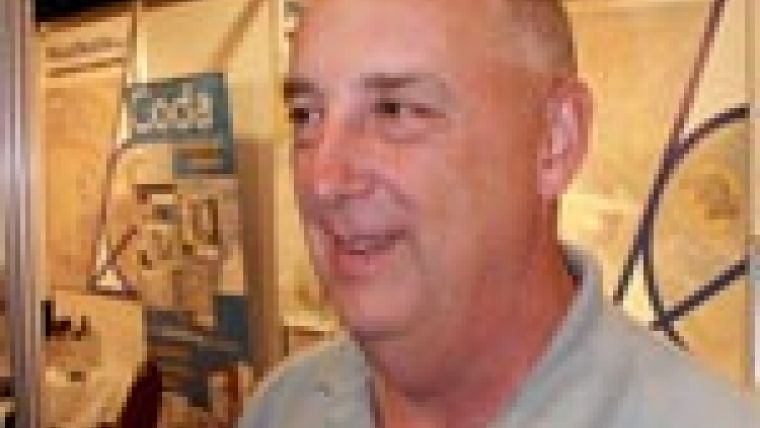‘I want to help the guys in the field'
Hypack founder Pat Sanders visited The Netherlands, presenting during the Holland Hypack Show which was organised by Nautikaris. Hydro International took the opportunity to interview him on various aspects of the business. Does Hypack have a rough ride? Is it difficult to expand and maintain the ‘close to the user' approach?
By Joost Boers, content manager, Hydro International
Hypack exist for more than 20 years, how did the company start?
Sanders: ‘After serving as a hydrographer with the Naval Oceanographic Office, I left for business school to become a Captain of Industry. It turns out that I was only going to be a Private of Industry', so I took a couple of consulting jobs in hydrography. I developed several programmes to help me in my consulting work. By 1987, I had enough pieces and decided to package them together and offer them for sale. In the early 1990s, a HYPACK programmer named Mircea Neacsu, was tasked to develop a program to track multiple vessels. He came back to me with a program written for something called ‘Windows'. I pooh-poohed it and wrote something in DOS. Luckily, Mircea was very persistent and HYPACK was soon available in Windows before our competitors. The name HYPACK is easy to explain: Hydrographic Package. We sold zero packages our first year and 2 or 3 our second year. Now, we sell two or three licenses a day world-wide.'
Your company puts lots of efforts in the users. Why?
In November, the count was about 5,000 licenses used by 2,800 organizations. Since our first edition, the package has evolved based on the feedback of the users. That's why these training seminars are so important: the users have an different types of equipment, different geodesy, different survey requirements and they can provide us great feedback on what works, what doesn't work and areas that we need to develop to make the package more useful to them.
Which direction do you see in the market?
Hardware and memory continues to improve as it gets cheaper. The computer is about the cheapest item on your survey boat. We have users collecting and processing data on USD600 laptops. There are now multibeam systems that cost about the same as a high-end single beam echosounder. More and more users are moving towards multibeam surveying. There is also more emphasis on data visualization. You see less demand for charts with plotted soundings and more emphasis on graphical imagery. Google Earth and Microsoft Virtual Earth are great tools and we have already begun to export data to KML in order to add it to their displays. In the future, we will see 3D harbor imagery the same way you can now see 3D buildings on land areas. The ability to export hydrographic data for display in third party software will continue to be a focus of our development.
What is most challenging nowadays?
There are a few challenges. The developments in survey equipment require us to constantly update and create new interfaces into HYPACK. It's very frustrating when a company sends you the format for a data string and then expects everything to work perfectly. We much prefer to actually get our hands on the equipment for a couple of days in order to make sure it works properly. We try to avoid ‘one-off' situations that are for a particular client and not of interest to our user base. Another challenge is staying on top of customer support. We are adding 1,000 users per year, on top of our existing user base. That requires being able to answer more questions, provide more training and holding more training seminars. We know how it feels to be on a survey vessel when things aren't working and the client is breathing down your neck. I want to help the guys in the field.
You don't mention the economic situation...
No. Our sales continued to grow in 2008 and we have not yet encountered a downturn. As we base the package price in US Dollars, the low value of the dollar has given us a substantial price advantage when compared to our European-based competitors. I believe that the real estate related dredging market has dried up a bit. I also believe that the hydrographic market will be receiving a ‘surge' as several governments invest in infrastructure projects in order to stimulate their economies.
What do you see of the consolidation going on? Hypack could be a target.
I'm not that worried. HYPACK is a small company and is very independent (to the point of being stubborn). This independence allows us to work with all of the equipment suppliers. We try our best to treat each one of them fairly and give them a means to have their equipment successfully integrated in a hydrographic package. Once a software company is taken over by a large company, they often are forced to focus on that company's product line, to the neglect of the other vendors. That can be the ‘kiss of death' for a software package.
These seminars are to introduce the 2009 version of Hypack. What is the evolution?
We are constantly updating the software and now offer a new ‘release' at the beginning of each year. These releases include integrations of new systems, new programs and algorithms (such as the incorporation of Geocoder from UNH-CCOM and the export to Google Earth). Every year, beginning in October, we prepare a new 3-day training program for our users. After the USA seminar in January, we take the same program to 15 different countries. The seminars provide us with great feedback. We learn from the users how things really work (or don't work) and where we need to improve. The users always find some things that our programmers and testers missed and we then take steps to fix it.
The interview has been taken during the Holland Hypack Show, organised by Nautikaris.














